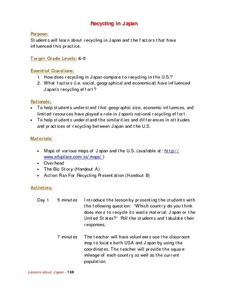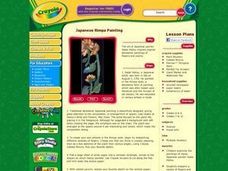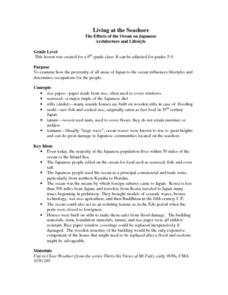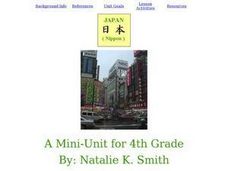Teach Engineering
Earthquakes Living Lab: Geology and Earthquakes in Japan
Sometimes it seems as if earthquakes hit the same places over and over again. Class members study Japan in order to determine why earthquakes keep happening there. Pairs work together to research and try to determine whether there...
Curated OER
Comparative Government: Japan & the United States
Students compare the governmental systems of Japan and the United States. As a class, they discuss the differences between the parliamentary system and the presidential system. Pupils read provided handouts about the duties of a a...
Curated OER
Breaking News English: Robots in Japan
In this Robots in Japan worksheet, students read the article, answer true and false questions, complete synonym matching, complete phrase matching, complete a gap fill, answer short answer questions, answer discussion questions, write,...
Curated OER
Recycling In Japan
Students participate in a lesson that is focused on the concept of recycling. They conduct research to find out about the history of recycling and how it is done in the present day.
Curated OER
ENVIRONMENT AND CONSERVATION: JAPAN
Students explain conditions and motivations that contribute to conflict, cooperation, and interdependence among nations; and analyze the causes, consequences and possible solutions to resource allocation, conservation, and economic...
Curated OER
Breaking News: Second Explosion at Japan Nuclear Plant (14th March, 2011)
Students explore current events by sharing information about the Japanese nuclear plant. In this nuclear energy lesson, students discuss the pros and cons of nuclear energy plants and whether or not they can typically withstand natural...
Curated OER
Japan and The Ring of Fire
Middle schoolers engage in a study of the volcanic forces and earthquakes associated with The Ring of Fire in the Pacific Ocean. The people of Japan are researched in how they have dealt with living in the area. Also students write in...
Curated OER
Koi Pond
Create this beautiful koi pond scene using watercolor paper, crayons, and paints. This would be a fantastic project to link to a scientific study of pond life or a historical study of Japanese culture.
Curated OER
Japanese Rimpa Painting
Students examine the life and work of Sakai Hoitsu. Using the Internet, they discover how he made his paintings using a special technique. Individually, they make their own painting using the same style and use watercolors to complete...
PhET
Radioactive Dating Game
Uranium 235 has a half-life of over 700 million years and is the fuel used in the atomic bomb dropped on Hiroshima, Japan. Pupils see the half-lives and decay rates of Carbon-14 and Uranium-238. They also take measurements of these two...
Teach Engineering
Earthquakes Living Lab: Geology and the 1906 San Francisco Earthquake
We can learn from the past to protect the future. Pairs look at two historical earthquakes: San Francisco, Calif., and Kobe, Japan. Pupils compare the two earthquakes and their impacts, then determine how engineers may use the...
Curated OER
Living at the Seashore
Students examine how the proximity of all areas of Japan to the ocean influences lifestyles and determines occupations for the people. This lesson includes lesson extensions and a concept list.
Curated OER
Chicago Questionnaire
Pupils critically investigate the issues surrounding the dropping of atomic bombs on Japan. They conclude if dropping the bombs was a correct decision or not and support their conclusions with documentation. Students tie in atomic bombs...
Curated OER
Atomic Age Critical Thinking
Students research and discuss issues surrounding the atomic bomb and the concerns it raised and the consequences of dropping the atomic bombs on Japan. A variety of sample questions are provided to engage discussion.
Curated OER
Social Studies: Exploring Japan
Fourth graders examine the culture and environment of Japan, beginning with a KWL chart. They use clay and cups of water to construct representations of the Japanese Islands. After designing flags representing farming and food, 4th...
Curated OER
Natural Wonders of China And Japan
Students identify some of the attributes of China and Japan and compare and contrast the way Chinese, Japanese, and American artists represent nature in art. The lesson is for upper-elementary classrooms.
Curated OER
Our Disastrous World
Students explore natural disasters around the world from the experiences of other students, friends and families. They collaborate with countries such as Japan, China, India, Australia, Russia, Great Britain as well as from the United...
Polar Trec
Playground Profiling—Topographic Profile Mapping
The Kuril islands stretch from Japan to Russia, and the ongoing dispute about their jurisdiction prevents many scientific research studies. Scholars learn to create a topographic profile of a specific area around their schools. Then they...
Science Matters
Earthquake Building/Shaking Contest
Japan is one of only a handful of countries that constructs buildings that are almost earthquake proof. The 13th lesson in the 20-part series challenges scholars to build structures to test against earthquakes. With limited materials and...
Curated OER
A Yen for Maximum Residue Limits in Food
Future public health officials or agriculturists read an article and answer questions concerning the Japanese regulations for pesticide exposure. They compare the maximum residue limit for two, 4-D of Japan with other countries. This is...
Curated OER
Collision Course
Students measure the speed of moving marbles and use the results to calculate velocity and momentum. They analyze the events preceding a Japanese train crash.
Curated OER
Why is rice important?
Second graders examine why rice is so important to the world. In this agriculture lesson, 2nd graders discover the origins of rice farming. Students study how many countries depend on rice for survival. Students research countries and...
Curated OER
A Whale of a Difference
Students research various perspectives on Japan's commercial whaling industry and formulate position papers representing these views. They read the Times article, Yuk! No More Stomach for Whales. Groups present their perspectives on...
Curated OER
Tour du Jour?
Young scholars read an article about tourism in Hokkaido, Japan and address the impact of global warming on world wide tourist destinations. They make posters predicting the impact of warmer temperatures on various tourist attractions
Other popular searches
- Japanese
- Japan Geography
- Feudal Japan
- Japanese Film
- Japanese Art and Music
- Imperial Japan
- Japan History
- Japanese Culture
- Ancient Japan
- Japanese Internment
- Medieval Japan
- Japanese Art























